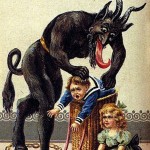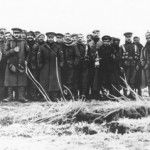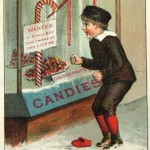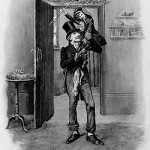Christmas Facts Wrap
Santa Claus has long been the symbol of Christmas, bringing joy and presents to all the good girls and boys. But if you are child in Germany, Austria, and other parts of the Alps region, there may be something much more dark, mischievous, and grumpy hidden in the shadows next to dear old St. Nick. That something is Krampus, the Christmas demon. A beast-like creature with fangs, fur, and horns, Krampus announces his presence with loud bells and terrorizes the kids who have been naughty during the year. While Santa gives the good ones gifts and joy, Krampus gives the… (more)
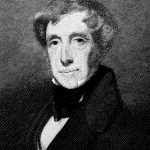 The Anonymous Publishing of “The Night Before Christmas,” and Other Interesting Christmas Staple Origins
The Anonymous Publishing of “The Night Before Christmas,” and Other Interesting Christmas Staple Origins
On December 23, 1823, the poem A Visit from St. Nicholas, better known today as The Night Before Christmas was first published. The poem first appeared in the New York Sentinel with no author listed, having been delivered for publication by a friend of Clement Clarke Moore, who was a professor of Greek and Oriental literature and who is generally considered today to have been the author. Before this poem was published, traditions surrounding St. Nicholas were numerous with no real set, near universally accepted idea of “Santa Claus” like we have today. Elements of the Santa tradition that ended up being popularized by this poem include: the names and number… (more)
 Eating Kentucky Fried Chicken is a Christmas Tradition for Many Japanese
Eating Kentucky Fried Chicken is a Christmas Tradition for Many Japanese
So how exactly did Christmas, the celebration of the birth of Jesus Christ, become synonymous with a bucket of fried chicken in the land of the rising sun? Well for one, Christmas wasn’t really celebrated at all historically in Japan and has only relatively recently been adopted. The Japanese predominantly followed the Buddhism and Shinto religions, so Christmas was essentially adopted from the West and holds no religious significance to many Japanese, even today. In fact, Christianity was actually banned throughout Japan in the 1600s and continued to be so until the mid 1800s. However, during this period, a small enclave group of… (more)
On the whole, people don’t generally like to kill one another. Most wars throughout history are often more about the agendas of the state’s leaders than the soldiers on the field actually inherently feeling any real malice towards those they are asked to try to kill or otherwise defeat. Few events in history illustrate this as well as a remarkable episode that took place during WWI when, despite the orders of their commanding officers and leaders, the soldiers threw aside their weapons, got out of the trenches and had a make-shift Christmas party with those that just hours before they’d been trying to kill. This momentous event has become known as The Christmas Truce. Leading up to this impromptu truce in 1914, Pope Benedict XV had asked that the various governments participating… (more)
 5 Bizarre Christmas Traditions
5 Bizarre Christmas Traditions
Christmas around the globe is celebrated with many customs and traditions. Often the traditions are similar with only slight variations from country to country, but some Christmas traditions are truly bizarre. 1) In the nine days leading up to Christmas Day in Venezuela, the people attend an early morning mass. This may seem like a pretty normal tradition, but in the busy city of Caracas, on Christmas they skate to mass on roller skates. Firecrackers pop to wake the citizens, who put on their skates for the pre-dawn trip to mass… (more)
 The “X” in “Xmas” Doesn’t Take the “Christ” Out of “Christmas”
The “X” in “Xmas” Doesn’t Take the “Christ” Out of “Christmas”
Myth: “Xmas” is a non-religious name / spelling for “Christmas”. It turns out, “Xmas” is not a non-religious version of “Christmas”. The “X” is actually indicating the Greek letter “Chi”, which is short for the Greek![]() , meaning “Christ”. So “Xmas” and “Christmas” are equivalent in every way except their lettering. In fact, although writing guides such as those issued by the… (more)
, meaning “Christ”. So “Xmas” and “Christmas” are equivalent in every way except their lettering. In fact, although writing guides such as those issued by the… (more)
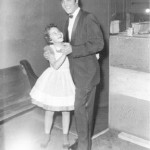 Brenda Lee was Just 13 Years Old When She Recorded the Christmas Staple “Rockin’ Around the Christmas Tree”
Brenda Lee was Just 13 Years Old When She Recorded the Christmas Staple “Rockin’ Around the Christmas Tree”
Brenda Mae Tarpley (a.k.a. Brenda Lee and “Little Miss Dynamite”) was born to an extremely poor family in December of 1944. Things took a turn for the worse when her father, a onetime semi-pro baseball player and carpenter, died in a construction accident in May of 1953 when she was 8 years old. Within two years of this happening, the 10 year old girl started taking over her deceased father’s role as the primary bread winner of the family, with frequent performances on various TV and radio shows, as well as in record shops- then her big break happened when she sang in front of future Country Music Hall of… (more)
 Why We Kiss Under the Mistletoe
Why We Kiss Under the Mistletoe
If you’ve ever wondered why we kiss under the mistletoe and how the plant got that strange name, well, wonder no more. The name for mistletoe derives the fact that mistletoe tends to spring from bird droppings that have fallen on trees, with the seeds having passed through the digestive tract of the birds. Thus, the plant was given the name “misteltan” in Old English from “mistel”, meaning “dung”, and “tan”, the plural of “ta”, meaning “twig”. Hence, “mistletoe” is another way to essentially say “dung twig”. Not only is mistletoe a dung twig, but most varieties of this plant are partial parasites, being unable to sustain themselves on their own photosynthesis, so they leach what they need from the particular tree they are growing on. Some varieties of mistletoe, such as the North America Arceuthobium pussilum, are full parasites in that they… (more)
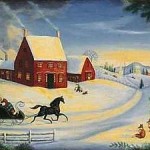 The Song “Jingle Bells” Is Thought to Have Been Written for a Thanksgiving Sunday School Program
The Song “Jingle Bells” Is Thought to Have Been Written for a Thanksgiving Sunday School Program
ingle Bells was originally called One Horse Open Sleigh and was written by James Pierpont sometime between 1853 and 1857. At the time, Pierpont was working as an organist and music director in Savannah, Georgia. Pierpont was hired on by his brother, John Pierpont Jr. who was the Reverend there, after James’ business in San Francisco burned down. It was here that he composed One Horse Open Sleigh, reportedly for a Thanksgiving program. He later publicly released the song through Ditson and Co. of Boston in 1857, but it wasn’t terribly popular. Pierpont tried again to release it in 1859 under the new title Jingle Bells, with it once again flopping. However, from there, it did slowly… (more)
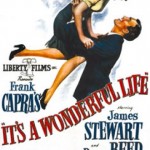 It’s a Wonderful Life was Based on a “Christmas Card” Short Story by Philip Van Doren Stern
It’s a Wonderful Life was Based on a “Christmas Card” Short Story by Philip Van Doren Stern
It’s a Wonderful Life was based on a “Christmas Card” short story by Philip Van Doren Stern, which was originally sent out to around 200 of Stern’s friends and family in December of 1943. The short story was called The Greatest Gift and was inspired by a dream Stern had one night in the 1930s. Stern, already an accomplished author at this point, albeit a historical author, then proceeded to write the 4,000 word short story about a man named George who was going to commit suicide by jumping off a bridge… (more)
First, let’s start by dispelling a somewhat popular myth that more or less goes like this: “The white base color of the candy cane symbolizes Jesus’ purity; the red stripes symbolize Jesus’ blood when he died on the cross; and the J shape was chosen to represent the J in Jesus.” While that makes a great candy cane origin story, there is about as much evidence to back this up as there is supporting the myth that Mr. Rogers was once a sniper in the U.S. military and always wore long sleeve sweaters to cover all the tattoos on his arms and chest, one for each… (more)
 The Song “Silver Bells” was Originally Called “Tinkle Bell”
The Song “Silver Bells” was Originally Called “Tinkle Bell”
To make matters slightly more humorous, Silver Bells originally appeared in the The Lemon Drop Kid, a 1951 film starring Bob Hope. Needless to say, these two things would have surely resulted in the song getting a few chuckles, had composer Jay Livingston’s wife, Lynne Gordon, not stepped in. Said Ray Evans (one of the two composers of Silver Bells, along with Jay Livingston- Livingston writing the music and Evans… (more)
 The Guy Who Did the Voice for Tony the Tiger also Sang “You’re a Mean One, Mr. Grinch”
The Guy Who Did the Voice for Tony the Tiger also Sang “You’re a Mean One, Mr. Grinch”
The guy who did the voice for Kellogg’s Tony the Tiger also sang the iconic “You’re a Mean One, Mr. Grinch” song in Dr. Seuss’ How the Grinch Stole Christmas. The man was Thurl Ravenscroft. Ravenscroft originally went unintentionally uncredited in the film. Because of this, a common misconception… (more)
In Charles Dickens’ holiday classic, A Christmans Carol, the character of Tiny Tim dies in one timeline, but is saved by Ebenezer’s Scrooge’s charity in another. Although Dickens scholars have posited a range of maladies that can either cause death or be alleviated by throwing money at it, a recent study has led to the conclusion that he likely suffered from both tuberculosis (TB) and rickets, as you’ll soon see. In the well-loved Christmas tale (it has never been out-of-print since it was first published in 1843), the protagonist (so to speak) is Ebenezer Scrooge, the miserly boss of Bob Cratchit… (more)
That poinsettias are not poisonous, contrary to popular belief. The belief that they are poisonous originally seems to have started around 1919 when a two year old child of a U.S. Army officer died after supposedly eating poinsettia leaves. The poinsettia leaves were blamed for the death, even though there was never any actual evidence that the poinsettia leaves had anything to do with the child dying, according to The American Society of Florists… (more)
Traditionally, yes, eggnog included raw eggs. However, some countries today, such as the United States, severely restrict the use of raw egg in products, due to health concerns; thus, most commercial eggnog does not include raw eggs. (The FDA actually limits the egg yolk solids in eggnog to less than 1%.) You can, however, buy pasteurized eggs first before making your own eggnog (or partially cook the raw egg in milk to make a custard), but eggnog connoisseurs tend to frown upon this as it supposedly alters the flavor and consistency of the final product. As to what typical ingredients are included in eggnog, these are: milk; cream; sugar; some sort of an alcohol like rum… (more)
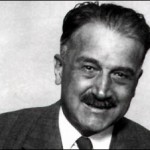 The Real Life “George Bailey” Who Founded Bank of Italy which Became Bank of America
The Real Life “George Bailey” Who Founded Bank of Italy which Became Bank of America
The man was A.P. Giannini who was said to be who Capra modeled the character of George Bailey as well as the bank president in Capra’s 1932 movie, American Madness, after. At the age of 14, Giannini left school and began working with his step father, Lorenzo Scatena, in the produce industry as a produce broker. By the time he was 31, he was able to sell much of his interest in this company to his employees and had planned to retire. However, one year later, he was asked to join the Columbus Savings & Loan Society, which was a small bank in North Beach, California. Once he joined up, he… (more)
 12 Christmas Traditions From Around The World
12 Christmas Traditions From Around The World
In Russia and Ukraine, Christmas is celebrated on the 7th of January and not the 25th of December like in most other countries. This unusual date is because the Orthodox church uses the old “Julian” calendar for religious celebration days. In the traditional Russian Christmas, special prayers are said and people fast, sometimes for 39 days, until January 6th (Christmas Eve), when the first evening star in appears in the sky. Then begins a twelve course supper in honor of each of the twelve apostles… (more)
| Share the Knowledge! |
|

